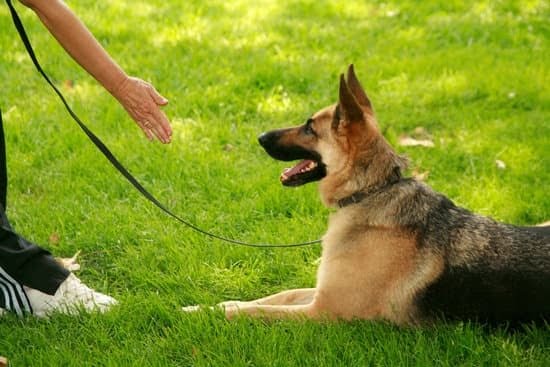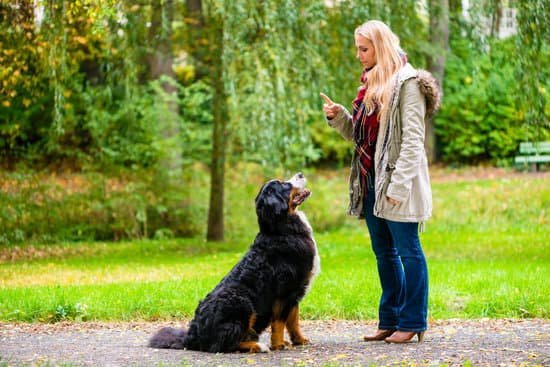Introducing specific verbal commands
In addition to being effective in training your pet, adding specific verbal commands can be beneficial in reinforcing discipline and teaching your older dog when they should stop barking. Start by introducing basic commands like “no bark” or “quiet”, along with other key phrases that help your pet learn what is expected of them. Additionally, you may want to include body language cues such as raising a hand or making eye contact, which can be successful in communicating the message that excessive barking isn’t acceptable. Consistency is especially important when attempting to train this behavior out of an older pup, so be sure to practice these commands daily and always reward good behavior with positive reinforcement. With patience and proper technique, it should not take long for your pet to fully understand that consistent obedience is expected from them.
Establishing Barking Rules
When training an older dog to stop barking, it is important to establish a set of rules regarding when, why and how much your pet can bark. Establishing these expectations provides consistency that is necessary for order in your home and helps ensure that your pet understands what behavior you are expecting from them.
To begin establishing the rules for barking, it can help to act preemptively and set specific guidelines for when the pet should be allowed to bark. Some owners allow their pets limited barking throughout the day in specific circumstances where it might be appropriate such as when visitors enter the home or when strange animals pass by outside. These boundaries will provide structure to your pet’s life and alleviate unnecessary barking from triggering situations like boredom or lack of stimulation.
In cases where your dog is barking inappropriately or excessively, time out or other forms of positive punishment can be used to reinforce negative behaviors like inappropriate barking. For example, if you notice that when you’re gone all day your dog barks excessively out of loneliness or boredom, try providing interactive puzzle toys during those times so they have something productive to do while you’re away instead of relying on excessive vocalizations. If the old behavior persists after trying these methods then more negative reinforcement is needed. Try exclusion training; use a room or crate that may provide a certain level of safety while out yet restricts excess barkings such as access to windows facing noisy streets or rooms that contain tables with a higher propensity towards destructive behavior due to its contents. Additionally, ensure that you are consistently monitoring and praising positive behaviors at the appropriate intervals — this will solidify expectation between you and the dog by providing verbal and physical support whenever the appropriate behavior is displayed which creates consistency over time for both parties involved (dog & owner).
Positive Reinforcement
Positive reinforcement is a terrific way to train an older dog to stop barking. It involves scientifically proven methods that promote positive behavior, reward obedience and create long-term positive associations with behaviors like not barking. Rewards can come in the form of praise, treats, special toys or other desirable items that your dog will find rewarding. Building up a repertoire of rewards your pet enjoys and making sure they are available when needed is key for successful training.
As soon as your dog stops barking, it is important to reward them immediately because this helps to reinforce the desired behavior and make the training stick. Every time you provide a reward for not barking, the connection between obedience and rewards strengthens until eventually, your pet won’t even consider barking as a potential option. If you know what rewards your pet takes pleasure from then use those specific items each time you have success during training sessions. Overall, combine gentle exposure to noise with positive reinforcement to help your beloved pup learn new behaviors without resorting to barking.
Breed and Age Specific Solutions
For some breeds and ages of dogs, barking can be a stubborn habit to break. It’s important to understand the contributing factors that lead to excessive barking, such as boredom, loud noises, or territoriality. By understanding the cause behind the behavior, you can better equip yourself with tools and techniques that work for your specific dog.
For older dogs who bark out of boredom or territoriality, try redirecting their attention with activities such as walks or fetch in order to ease any anxiety they may have. Begin by observing when they bark; if you notice that it’s while they’re outside in the yard, either take them inside or share tasks and games that keep them occupied outside to address their feelings of insecurity. A high-quality chew toy can also provide some distraction and allow your pup to contain their urge to bark until it has been extinguished altogether.
If loud noises cause your older dog to bark incessantly, work toward desensitizing them from loud sounds over time by replaying recorded noises on low volumes and gradually increasing the volume after each play session. Whenever your pup shows signs of feeling anxious or overwhelmed during this process, step back a few notches; rewards should be given frequently during positive reinforcement sessions in order to encourage progress. You may wish to consider investing in noise reduction products such as earmuffs or white noise machines if all else fails.
Keeping Records
When working with an older dog to stop barking, it is important to keep track of your progress. Keeping records of the amount of barking and its intensity over a period of time can help to further define the causes and triggers behind the barking in order to create more effective strategies for eliminating it. Taking detailed written notes or using a mobile app that tracks frequency and duration as well as whether the behavior is increasing or decreasing can provide invaluable insight into your pet’s barking habits. Additionally, making note of any modifications in routine or environment during this process will also allow you to identify if there are any factors beyond training that are having an impact on your dog’s behavior. Doing this work up front can help ensure that you have all the knowledge necessary when it comes time to apply formal training techniques and behavioral modification methods.
Professional Advice
A professional dog trainer can be an invaluable resource if you are trying to train an older dog to stop barking. In many cases, the cause of the barking isn’t clear and a professional may be able to assess the behavior and create an individualized plan. The plan can address any potential medical issues that may be contributing to the problem, as well as give tips on teaching basic commands such as Sit, Follow Me and No Bark. Training techniques such as Positive Reinforcement are often effective in reducing barking. With Positive Reinforcement, rewards such as verbal praise or treats are used when the dog behaves the way you want them to (not barks). It is important for owners to remain consistent with training sessions; positive results will not manifest over night – it requires patience and dedication. It is also important to keep a close eye on the behavior in order for good progress to continue. A trained professional will provide guidance on how best to help create desirable behaviors in your older pup.
Behavioral Modification
One of the most effective ways to train an older dog to stop barking is by using behavioral modification techniques. One example of a behavioral modification technique is positive reinforcement, which involves providing rewards when the dog follows commands or refrains from barking. For instance, if your dog barks when someone approaches the home, you could give him lots of praise and treats when he doesn’t bark and remain calm in response to people passing by.
It’s also very important to begin setting up boundaries and expectations with your older dog right away. Make sure they understand that they are not allowed to bark on command, while walking outside and when visitors come over. Use consistent punishment methods each and every time your dog barks inappropriately such as verbal corrections (such as “no barking”) and short timeouts for dogs that aren’t responding to verbal correction. If a timeout does not stop the barking, then physical punishment may be necessary (only advised if all other methods have already been tried multiple times).
When dealing with excessive barking due to boredom or anxiety, it’s important to address the underlying issue(s). A tired pup is less likely to bark out of boredom or frustration than one that isn’t getting enough exercise each day; therefore increase their daily activity level accordingly. Additionally, provide entertainment toys that can keep them occupied during long stretches at home alone (or with other canine pals). Finally, practice relaxation techniques such as deep breathing exercises anytime your pup appears stressed in order to shift their focus away from negative triggers leading them toward excessive barking episodes.
Reducing Stress
An older dog’s barking can be caused by anxiety, confusion, discomfort, or even pain due to age-related conditions. To reduce stress and help prevent barking in an older dog, it’s important to provide them with a routine and support structure. Make sure they get enough exercise daily and that they are socializing with other dogs. Create a comfortable environment in the home by providing them with plenty of bedding or soft mats to rest on; this will help promote relaxation and reduce symptoms of anxiety.
To ensure their physical health is maintained as they age, schedule regular veterinary check-ups including bloodwork every 1–2 years. Senior dogs also benefit from daily joint supplements (e.g. omega 3 essential fatty acids), glucosamine-chondroitin products, enrichment activities such as feeding from kongs or puzzle toys in order to keep the mind stimulated and active, cognitive support supplements (if recommended by your veterinarian) for mental alertness and the added bonus of calming pheromones available in crate/pet coat sprays which can help create a sense of safety within the environment.
It’s also important to take time to practice training exercises routinely which focus on obedience commands and calming techniques such as massage therapy for good touch reassurance when needed (see low stress handling online for additional guidance). If there is a particular environmental or life event stimulus that is causing excessive barking behavior then professional consultation may be beneficial in order to determine appropriate training interventions which will best serve them longterm.

Welcome to the blog! I am a professional dog trainer and have been working with dogs for many years. In this blog, I will be discussing various topics related to dog training, including tips, tricks, and advice. I hope you find this information helpful and informative. Thanks for reading!





